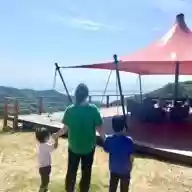Children’s songs, folk songs, and nursery rhymes about insects
We’ve put together a collection of children’s songs about insects.
Don’t worry—by insects we don’t mean the kind everyone dislikes, like cockroaches, but rather the beloved ones such as butterflies, ladybugs, honeybees, and red dragonflies.
The selection includes a variety of songs: newer children’s tunes, folk songs, traditional nursery rhymes, and classic playground songs.
Many boys in particular seem to love insects, so teaching them these songs might make them happy.
Cute insect songs are also popular with toddlers, so they’re definitely worth learning.
- [Children’s Songs of Autumn] Autumn songs, school songs, and traditional children’s rhymes. A collection of classic pieces to sing in autumn.
- [Childcare] Recommended songs and nursery rhymes for November: Fun autumn fingerplay songs
- Nursery rhymes and fingerplay songs to enjoy in May! Songs perfect for the fresh green season
- A collection of classic nursery rhymes and hand-play songs for September! Enjoy autumn with your child through songs.
- Children’s songs and nursery rhymes about the moon
- [Sea Nursery Rhymes] Fun children's songs themed around the sea
- Snake Song: Children's song, nursery rhyme, and hand-play song
- [Children’s Songs for June] Fun finger-play songs and traditional nursery rhymes perfect for the rainy season
- Children’s songs, folk songs, and nursery rhymes for March: fun spring hand-play songs.
- Song of the Maple Leaves. An autumn children’s song/nursery rhyme/folk song
- Nursery rhymes I want to sing in July: fun summer songs
- Children’s Songs You Can Sing in August: Summer-Friendly Kids’ Songs and Fingerplay Rhymes
- Nursery rhymes, folk songs, and children's songs about animals
Children’s songs, folk songs, and nursery rhymes about insects (21–30)
ladybugLyrics by Aki Shimizu / Music by Tsuyae Kobayashi

A children’s song lovingly sung by Aki Shimizu and Tsuyae Kobayashi about a small red insect.
Set to a bright, lighthearted melody, it gently portrays the charming creature with its red body and distinctive black spots.
The song is included on the albums “Kodomo no Uta 200,” “Let’s Sing About Nature!,” and in the 1981 publication “Minna no Uta: 86 Songs,” and has long been beloved by many children.
With its friendly tune, it’s the kind of song you’ll find yourself humming on a leisurely spring day while out for a stroll.
It’s perfect not only for music activities in nurseries and kindergartens, but also for families to enjoy together while experiencing the nature of spring.
honey honey honey

This is a children’s song composed by Yoshinao Nakata, famous for pieces like “Chiisai Aki Mitsuketa” and “Medaka no Gakkō.” The lyricist, Chiyoko Tsuruoka, was a poet also known for writing lyrics for choral works.
There is another song with the same title, with lyrics by Akiko Hirata and composition by Hiroko Masuda.
Caterpillar rolling around

It’s a children’s nursery song.
There seem to be various versions of how to play along: rolling side to side while singing with the child, rocking or lifting a baby while holding them on your lap, or having children crouch and hold onto the person in front to march together.
Also, the version sung by Akiko Yano is included on the album “Tokyo wa Yoru no Shichiji” (Tokyo at 7 p.
m.
).
Orphan Hachi

This is the theme song of the 1970 TV anime “Insect Story: Hutch the Honeybee.” It describes the story of Hutch, a honeybee who is separated from his mother after an attack by hornets and embarks on a difficult journey to find her.
It’s an anime song that leaves a strong impression.
The singer, Yuri Shimazaki, was in her first year of junior high school at the time.
Sky of my hometown

This is a song that sets lyrics by Takeki Owada—famous for works like “Tetsudō Shōka”—to a melody from a Scottish folk tune.
It was published in 1888 as one piece in the song collection “Meiji Shōka, First Series,” edited by Owada and Yoshiyoshi Oku.
It includes a depiction of “suzumushi” (bell crickets).
Many versions with different lyrics exist, among which The Drifters’ “Dareka-san to Dareka-san” is particularly well known.
From “Songs of Living Things”: “Prologue,” “Song of the Cabbage White Butterfly,” “Song of the Sea Bream,” “Song of the Caterpillar,” “Song of the Grasshopper”

This work sets Rikuya Terashima’s music to poet Murō Saisei’s only poetry collection for children, “Animal Poetry,” turning it into a piece for children’s choir.
The collection contains a preface, an introductory poem, and 72 songs about various animals.
The suite uses the introductory poem as the first movement and consists of eight movements arranged roughly in the order of spring, summer, autumn, and winter.
The audio corresponds to the first half; after this, it proceeds to the songs “Dragonfly,” “Grasshopper,” “Duck,” and “Snow.” Each movement is a short piece of one to three minutes, featuring playful devices such as motifs that mimic insect characteristics and antiphonal exchanges between vocal parts, while also requiring passages of serene, restrained expression.
Buzzing bees

The lyrics were written by Junichi Kobayashi, a children’s literature author and nursery rhyme poet, and the music was composed by Ichiro Hosoya.
It was created for Uta no Obasan, a children’s song program broadcast on NHK Radio 1 from 1949 to 1964.
There is also a picture book of the same title by Kobayashi.





